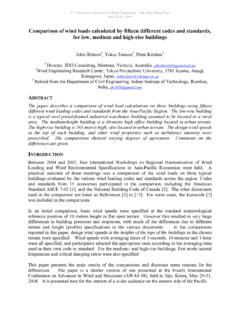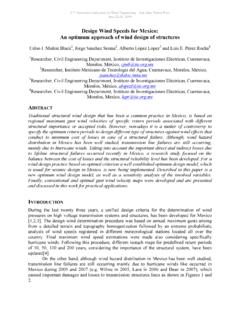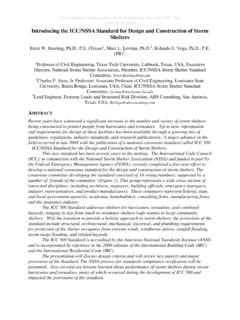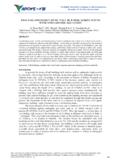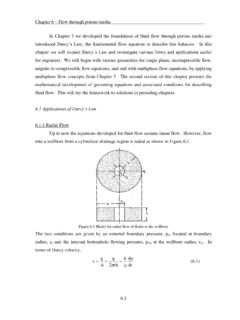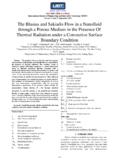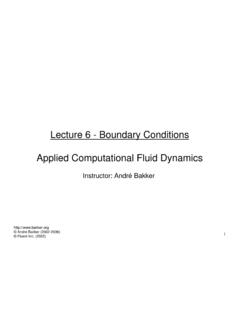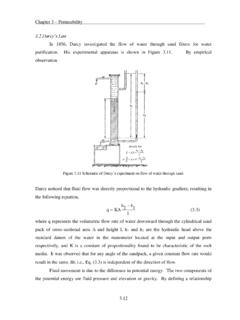Transcription of Wind Loads for High-Solidity Open Frame Structures
1 Wind Loads for High-Solidity open Frame StructuresSamuel D. Amoroso1 and Marc L. Levitan2 Principal Engineer, Engensus, Baton Rouge, Professor, LSU Hurricane Center, Baton Rouge, Frame Structures , such as those commonly found in industrial process facilities, are oftendenselyoccupied with processrelated equipment. This paper presents an alternative method forestimating wind Loads for High-Solidity open Frame Structures that differs from currentapproaches, which accumulatewind load contributions from various individual methodconsiders the structure as a porous block of arbitrary plan dimension that is subjectto wind from any direction.
2 The proposed method compares favorably with wind tunnel testresults for similar Structures . The possibility of defining an upper bound force coefficient is Frame Structures are common in the process industries. There are established methodsavailable to estimate wind Loads for open Frame Structures [1, 2]. Although these methods wereoriginally developed for lattice towers and unclad building frames, which often do not have theinternal equipment, ductwork, and piping that are common in the process industries, they havebeen extended for use in such applications. The basis of these methods is a summation of thecontributions to the wind load for separate components of the system (such as framing andequipment), taking into account aerodynamic interaction effects among the differentcomponents.
3 This approach works well for relatively open ( low solidity ) , as the overall solidity of a structure and equipment increases, not only do the methodsbecome more cumbersome, but their accuracy may be diminished as the simple, empiricalunderstanding of the aerodynamic interaction effects among the framing and equipment paper examines the wind Loads for more solid open Frame Structures from a differentperspective. Rather than accounting for the effects of the various components, the approach hereis to relate the force coefficient to variables which describe the overall geometry of theframe/equipment system.
4 The Frame and equipment together are treated as a generallyrectangular body with some degree of porosity. As such, the presumption of an understanding ofthe flow field effects among the various individual system components is abandoned, and theforce coefficient for the entire system is estimated as a whole. This paper briefly reviewsliterature relevant to the problem, presents an analytical basis for describing wind Loads on three-dimensional porous bodies, and examines the relationships between existing wind tunnel dataand relevant geometric variables. The possibility of estimating a reasonable upper bound forcecoefficient is also s Law is a method of describing the resistance to flow through porous media.
5 Thisresistance is characterizedby the pressure drop that occurs over the flow length. The pressuredrop is related to other physical characteristics of the flow in the followingEquation:LPkV (1)whereV = flow velocity (length/time), = dynamic viscosity of fluid ([mass length/time2] time/length2 ), P = pressure drop (mass length/time2 length2),L =length of flow path (length), andk = empirically derived permeability is appropriate for flows in which inertial effects are negligible. This is generally thecase when the flow under consideration is occurring in a microscopically porous medium such assoil or rock.
6 The Forchheimer equation [5] accounts for inertial effects in flows through porousmedia of more generic scales:2 VVLP (2)where = the inverse of the permeability index,k, empirically derived inertial parameter, andall other variables are as defined an approach such as the Darcy Law or its modification as the ForchheimerEquation is of limited utility in for estimating the wind Loads on petrochemical Structures for tworeasons: (1) all of the flow is considered to pass through the porous medium, but for a threedimensional structure , flow will increasingly be diverted around the body s boundaries as theresistance to through flow increases, and (2)Equation2 is really no different than the definitionof an empirical pressure coefficient for cases in which inertial effects are [6] addresses the balance of flow through and around porous plates by comparingthe process to the principle of minimum strain energy from mechanics.
7 Cook describestheoretical attempts to define the combination flows around and through a body but concludesthat it is necessary to resort to and Robinson[7] studied wind Loads on porous Structures , by which theyreferred to single planes of screens or fences. By interpreting various theoretical consideration inlight of both full-scale and wind tunnel experiments, they concluded that Loads onthesestructures are directly proportional to the Loads on their solid counterparts by the solidity also concluded that the loss coefficient (or drag coefficient) for these Structures varied withthe angle of wind incidence at a cosine-squared an application more closely related tothe problem at hand, Cook [6] offered anempirical relationship describing the relationship between the force coefficient, the windincidence angle, and the length to width aspect ratio of three-dimensional arrays or frames.
8 Theapproach was limited to relatively open Structures ( solidity ratio < ). The form of the equationreflects the fact that the maximum force coefficient for a structural axis occurs for winddirections that are skewed to the structural axes, and this effect increases as the relative along-wind length of the structure increases. The rate at which the force coefficient increases withlength/width ratio was given to be the aspect ratio to the to introducing any analytical considerations for the wind Loads on dense open framestructures it is necessary to establish sign conventions and other conventions for describing thegeometry of the system.
9 Figure1 is a schematic representation ofthe plan view of a genericstructure. The structure is shown to be rectangular in plan with coordinate axes oriented parallelto the sides of the structure . The side of the structure parallel to the x-axis has lengthL, and theside parallel to the y-axis has lengthB. The wind direction is measured with respect to thenegativex-axis and is designated . Some other geometric constructions are also shown inFigure1. The angle is formed between the side of the structure parallel to the x-axis and thehypotenuse of the right triangle with legs corresponding to the sides of the structure .
10 Theprojected width perpendicular to the wind direction is designatedB . The projected width varieswith wind angle such thatB is equal toBwhen = 0 radians, is equal to22LB when = /2 - radians, and is equal toL when = /2 1: Schematic planof a generic rectangular structure showing signconvention and angle conventionHaving defined the geometry of thesystem, it is possible to derive mathematicalrepresentations for (1) the variation of the force coefficient with wind angle for a given plancoordinate direction, (2) the angle at which the maximum force coefficient occurs, and (3) thevalue of the maximum force coefficient.
